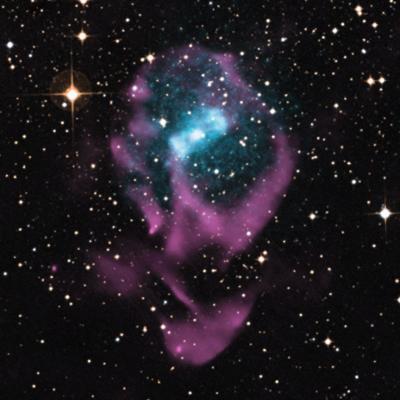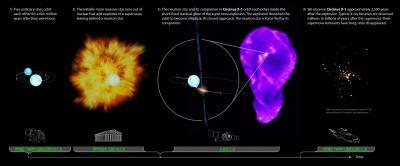X-ray binaries are star systems made up of two parts: a compact stellar remnant -- either a neutron star or a black hole; and a companion star -- a normal star like our Sun. The new discovery, made in parallel with a radio telescope in Australia, provides scientists with unique insight into the formation of neutron stars and supernovas, and the effect of the supernova's explosion on a nearby companion star. As the two objects orbit one another, the neutron star or black hole pulls in gas from the companion star, heating the gas to millions of degrees, producing intense X-ray radiation, and making these star systems some of the brightest X-ray sources in the sky.
To determine the age of Circinus X-1, the astronomers needed to examine the material around the orbiting pair of stars. However, the overwhelming brightness of the neutron star made it too difficult for researchers to observe that interstellar gas. The team recently caught a break, however, when they observed the neutron star in a very faint state -- dim enough for scientists to detect the X-rays from the supernova shock wave that plowed through the surrounding interstellar gas.
The youth of Circinus X-1 helps to explain its wild swings in brightness and the highly unusual orbit of its two stars, which had puzzled Brandt and other astronomers for years. "For a system this young that recently has gone through a supernova event, the orbit is likely to be eccentric, and the neutron-star's spin axis, the companion-star's spin axis, and the binary pair's orbital axis are likely to be quite misaligned," Brandt said. "Such misalignment will induce changes over time, which can help to explain the peculiarly strong long-term changes in the X-ray light that we see coming from Circinus X-1."

The youngest "X-ray binary" yet known turns out to be a neutron star cannibalizing its companion star. This animation zooms into a neutron star and the accretion disk it is accumulating from matter stolen from the companion star. More information is online at online at http://science.psu.edu/news-and-events/2013-news/Brandt12-2013, Duration: 16 seconds.
(Photo Credit: NASA Goddard Space Flight Center)
The team's research provides the missing context for understanding why the orbital time of the two Circinus X-1 stars is decreasing by several minutes every year. Brandt explained that this dynamic is plausibly the behavior that would be expected for a young X-ray binary affected by a supernova explosion before the gravitational pull of the stars on each other has had time to stabilize the orbit fully. Brandt contributed to the interpretation of the data and to the assessment of the scientific implications of the findings, and his calculations provided information about the expected orbital and other properties of the young binary system.
In addition to the Chandra data, radio observations from the Australia Telescope Compact Array were critical in these findings. NASA's Marshall Space Flight Center in Huntsville, Ala., manages the Chandra program for NASA's Science Mission Directorate in Washington. The Smithsonian Astrophysical Observatory in Cambridge, Mass., controls Chandra's science and flight operations.

The youngest member of an important class of objects in space has been found by a team that includes Penn State Distinguished Professor of Astronomy and Astrophysics Niel Brandt. This composite image shows the energies streaming toward Earth from this object -- X-rays in blue and the radio emission in purple. These energy detections have been overlaid in this image on an optical field of view from the Digitized Sky Survey. This discovery, which is described in a press release: http://science.psu.edu/news-and-events/2013-news/Brandt12-2013, allows scientists to study a critical phase after a supernova and the birth of a neutron star. Click here for more information about this image.
(Photo Credit: X-ray: NASA/CXC/Univ. of Wisconsin-Madison/S. Heinz et al; Optical: DSS; Radio: CSIRO/ATNF/ATCA)

This is an artist's conception of the life of X-ray binary systems and the young and turbulent history of Circinus X-1, which formed in a supernova explosion less than 4,600 years ago, approximately 500 B.C.E., making it the youngest known X-ray binary. More information is online at http://science.psu.edu/news-and-events/2013-news/Brandt12-2013.
(Photo Credit: University of Wisconsin-Madison)
Source: Penn State